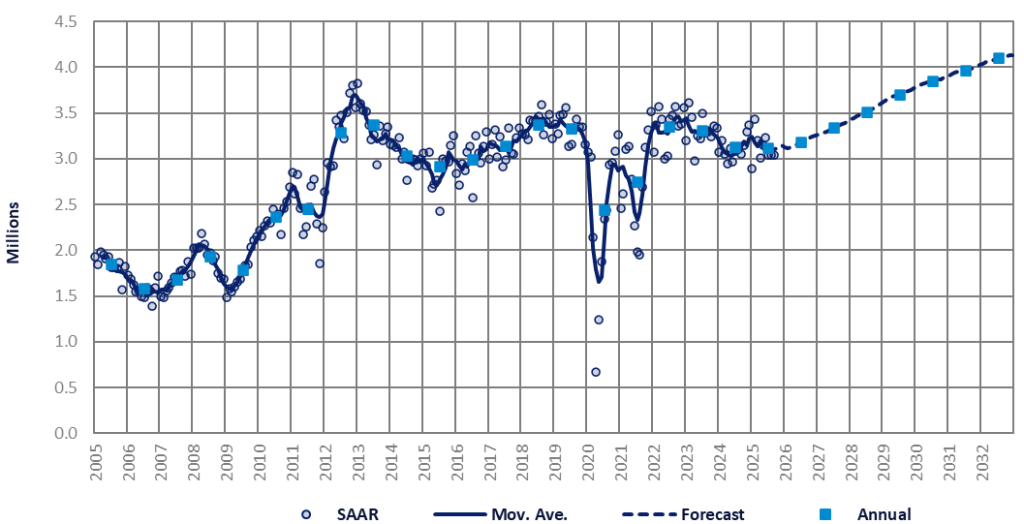The ASEAN LV market declined by 3.1% YoY in September, marking the third consecutive month of decline and resulting in a decrease of 2.5% YoY for Q3 as a whole. Consequently, regional sales decelerated from a 2.4% YoY increase in H1 to only a 0.7% YoY expansion in Q1-Q3. The negative sales performance in Q3 was primarily due to weak sales in Indonesia and the Philippines.

In Indonesia, LV demand sharply fell by 17% YoY in Q3 and 11% YoY in Q1-Q3 overall. This declining sales trend began after the government ended the temporary tax cut measures in 2022, which contributed to lower LV sales in 2023 and 2024, with declines of 3% YoY and 14% YoY, respectively. Other negative factors include: a) the government increasing VAT from 10% to 11% in April 2022 and to 12% in January 2025, leading to a higher cost of living and eroding purchasing power; and b) rising political controversy following the presidential election in 2024, which resulted in nationwide protests and increased military presence. Recent data indicated that Indonesia’s October sales dropped by 4% YoY but surged by 16% MoM.

Consequently, volumes in October reached the highest monthly total this year at 69k units. The month’s strong performance was attributed to BYD beginning deliveries of the affordable Atto 1 after receiving booking orders in July. October sales exceeded our expectations, prompting us to increase Indonesia’s 2025 sales projection to 730k units. In addition, the 2025 GAIKINDO Jakarta Auto Week (GJAW) is expected to further boost sales in November and December, while the government’s economic stimulus package starting in Q4 2025 should support LV demand to some extent.
In the Philippines, Q3 2025 sales dropped by 4% YoY, reflecting declines of 2%, 8%, and 3% YoY in July, August, and September, respectively. The poor results during the quarter were due to typhoons and flooding, along with a price hike for Pickups under the new tax scheme in July. However, volumes in Q1-Q3 2025 overall remained in positive territory, with growth of 5% YoY. This single-digit expansion can be considered a strong performance, as the market has been on the rise since 2022 and reached a new record high in 2024.
We have lowered the Philippines’ 2025 sales forecast but increased the outlook for 2026. This adjustment is based on severe typhoons and flooding in November, which are expected to significantly disrupt sales, leading consumers to postpone purchases and delay buying new vehicles until next year. Additionally, 2026 sales could be supported by replacement demand for vehicles damaged in the natural disaster. As a result, volumes are now projected to reach 474k units (+1% YoY) in 2025 and 493k units (+4% YoY) in 2026.
In Malaysia, Q3 2025 sales increased by 1% YoY, thanks to the launch of new models, particularly the refreshed Proton X50 and the newly launched Chery Tiggo Cross. Based on recent data, October sales continued to rise by 8% YoY, aided by price reductions and year-end sales campaigns. Additionally, the government has officially confirmed that it will not extend the tax exemption on imported BEVs, which will end in December 2025. This has led consumers to rush to purchase imported BEVs before the policy expires. Consequently, Malaysian LV sales fell by 1% YoY in January-October.

US Tariffs are shifting - will you react or anticipate?
Don’t let policy changes catch you off guard. Stay proactive with real-time data and expert analysis.
By GlobalDataFor Malaysia’s outlook, our scenario remains unchanged, with a decline of 2% to 803k units in 2025 and a further decline of 3% YoY to 775k units in 2026 projected. This forecast is based on the market achieving a new record high for three consecutive years from 2022 to 2024, supported by the tax-free policy on PVs and Perodua’s large backlog of orders. Furthermore, 2026 sales are expected to be negatively impacted by price hikes resulting from the end of tax exemptions on imported BEVs and the new tax calculation for locally built models. However, the forecast carries upside risks, as Malaysia’s GDP rose by 5.2% in Q3 2025, accelerating from a 4.4% increase in Q2. This Q3 GDP growth was supported by domestic consumption and the government’s one-off cash aid policy.
Thailand’s sales continued to increase by 24% YoY in September, driven by the introduction of a hybrid variant of the top-selling model—the Toyota Yaris Ativ—, aggressive sales campaigns, and the introduction of new BEV models from Chinese brands. According to our market intelligence, October sales were estimated at around 46k units (+26% YoY), which was stronger than our expectations. As a result, Thailand’s 2025 sales forecast has been raised to 590k units in this report. Additionally, Q4 2025 sales could be boosted by year-end sales campaigns and the expectation of price hikes from the new tax scheme in 2026.
Vietnam’s LV sales decelerated from a 41% YoY increase in H1 2025 to a 3% YoY rise in Q3 2025. However, in terms of absolute volume, the average monthly sales total in Q3 was 41k units, which is higher than the 39k units per month seen in H1. The marginal growth in Q3 was due to a high base last year. The Q3 and September results were in line with our expectations, and as such, we have maintained Vietnam’s 2025 sales outlook at 521k units.
In conclusion, the ASEAN 2025 LV sales outlook has been marginally increased from 3.09 million units in our previous report to 3.12 million units in this report, thanks to upward trends in Indonesia and Thailand. Additionally, the 2025 forecast carries upside risks, as demand in Malaysia and Thailand could be boosted by expectations of price hikes in 2026.


This article was first published on GlobalData’s dedicated research platform, the Automotive Intelligence Center.







